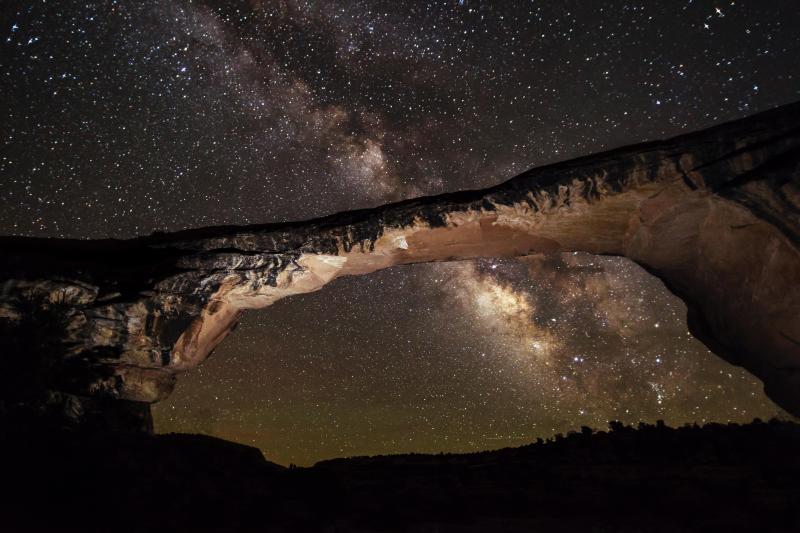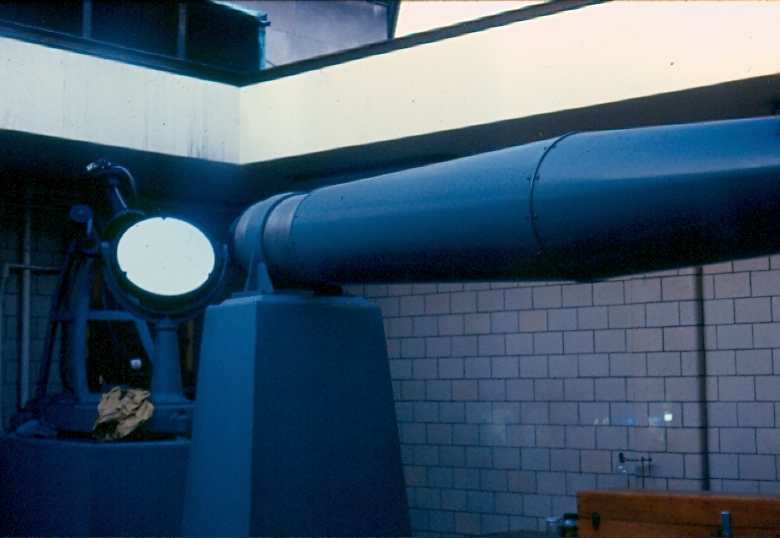
In 2006, Natural Bridges National Monument in Utah was designated as the world's first International Dark-Sky Park. This photograph shows the night sky at Owachomo Bridge. August 25 marks the centennial of America's National Park Service.
(Image Source: National Park Service; Photographer: Jacob W. Frank)
By Glenn A. Walsh
Reporting for SpaceWatchtower
Today (2016 August 25) marks the
centennial of America's National Park Service. And, since 2006,
several National Parks have been designated International Dark-Sky
Parks by the International Dark-Sky Association.
What became the world's first
designated National Parks has been described as “America's Best
Idea,” in the 2009 Public Broadcasting Service (PBS) historical,
television documentary series produced by Ken Burns. Although, U.S.
National Parks date long before the National Park Service was formed.
The earliest versions of National Parks
were the Hot Springs, Arkansas Reservation created by the U.S.
Congress in 1832 and the Congressional ceding of the Yosemite Valley
and Mariposa Grove of Giant Sequoias (Yosemite Grant) to the State of
California as a State Park for "public use, resort, and
recreation" in 1864. The smallest National Park by area, Hot
Springs became an official National Park in 1921. Yosemite was
designated a National Park in 1890, but it did not come under Federal
control until U.S. President Theodore Roosevelt (influenced by Sierra
Club Founder John Muir) signed a Congressional bill taking control
from California in 1906.
Yellowstone National Park became the
first official National Park in 1872. Yellowstone is considered the
world's first National Park, even though national nature preserves
had been established earlier in Germany (Drachenfels:1822)
and France (Forest of
Fontainebleau: 1861).
Federal control of Yellowstone was
necessary from the beginning, Unlike Yosemite, no state existed where
the Yellowstone National Park was formed, only a Federally-governed
territory. Yellowstone's boundaries are within parts of three states,
which did not join the Union until 1889-1890: Wyoming (1890), Montana
(1889), and Idaho (1890).
It was not until the U.S. Department of
the Interior had accumulated 39 national parks and monuments that
Congress formed the National Park Service, within the Department, to
administer parks and monuments in a comprehensive way. On 1916 August
25, U.S. President Woodrow Wilson signed-into-law the National Park
Service Organic Act.
Today, of the 412 sites managed by the
National Park Service, only 59 carry the designation of “National
Park.” Other sites have the designations of National Monuments,
National Historical Sites and Parks, National Natural Landmarks,
National Wildlife Preservation Areas, and Marine Protected Areas.
Completely separate from the National Park Service are National
Forests, managed by the U.S. Forest Service (established in 1891)
which is a division of the U.S. Department of Agriculture.
Throughout the later half of the 19th
century and through the 20th century, National Parks have
been dedicated to preserving wilderness and natural eco-systems,
sites of historical, cultural, natural, scientific, and educational
importance, and areas to protect wildlife. However, with increasing
national and world populations, and the greater urbanization of these
populations, it became increasingly evident that a new preservation
was needed---to preserve dark skies due to increased light pollution.
Outdoor lighting at night, that is not
properly shielded, can cause excess light to escape into the sky
causing sky-glow, which brightens the sky (which does not need
brightened) and drowns-out the dimmer celestial objects.
Additionally, this wastes light energy which could be better used on
the ground.
Excess light entering the eyes causes
eye-glare, which makes driving, cycling, or even walking, more
difficult. This also narrows eye pupils, greatly limiting night
vision, making it even more difficult to see dim objects in the night
sky.
Light pollution in most major cities,
today, make it difficult to observe anything but the Moon, planets,
and the brightest stars. And, since the constellations consist of
both bright and dim stars, it is becoming ever more difficult to
make-out constellations with the naked-eye from urban areas, since
many of the dimmer stars seem to be missing from where a
constellation should be found.
This light pollution also makes
astronomical observatories located within major cities less usable
for astronomical research. Most of these observatories are very
historic, as they were built in the 19th or early 20th
centuries, before light pollution became a problem. However, for
cutting-edge astronomical research to continue, money has to be spent
to build new observatories in remote locations away from urban areas,
or launched into Outer Space.
In 2001, the International Dark-Sky
Association, which had been established in 1988, started an
International Dark-Sky Places program "to protect locations of
exceptional nighttime visages for future generations." This
program includes three categories of International Dark-Sky Places:
International Dark-Sky Parks, International Dark-Sky Reserves, and
International Dark-Sky Communities.
Flagstaff, Arizona became the first
International Dark-Sky Community in 2001. Natural Bridges National
Monument in Utah became the first International Dark-Sky Park in
2006. The Reserve at Mont-Megantic in Quebec, Canada became the first
International Dark-Sky Reserve in 2008; thus far, all International
Dark-Sky Reserves are located outside of the United States.
Presently, there are seven U.S.
National Parks and National Monuments which have been designated as
International Dark-Sky Parks:
- Natural Bridges National Monument, Utah, United States, designated 2006
- Big Bend National Park, Texas, United States, designated 2012
- Death Valley National Park, California, United States, designated 2013
- Chaco Culture National Historical Park, New Mexico, United States, designated 2013
- Grand Canyon-Parashant National Monument, Arizona, United States, designated 2014
- Enchanted Rock State Natural Area (designated a National Natural Landmark in 1971), Texas, United States, designated 2014
AND, all children attending school in the fourth grade can obtain a free annual pass through the Every Kid in a Park program!
PLUS, Active-Duty Military Members and Citizens with a Permanent Disability can also obtain free passes to National Parks.
More Info - Link >>> https://www.nps.gov/planyourvisit/fee-free-parks.htm
Internet Links to Additional Information ---
International Dark-Sky Parks:
Link >>> https://en.wikipedia.org/wiki/International_Dark-Sky_Association#International_Dark_Sky_Parks
International Dark-Sky Association:
Link >>> https://en.wikipedia.org/wiki/International_Dark-Sky_Association
National Park Service ---
Link 1 >>> https://www.nps.gov/
Link 2 >>> https://en.wikipedia.org/wiki/National_Park_Service
National Park Service History: Link >>> https://www.nps.gov/aboutus/history.htm
National Park Service Centennial ---
Link 1 >>> https://www.nps.gov/subjects/centennial/index.htm
Link 2 >>> http://www.nationalparks.org/our-work/celebrating-100-years-service
Grand Canyon Receives Provisional Status, in 2016 June, as an International Dark-Sky Park:
Link >>> http://spacewatchtower.blogspot.com/2016/08/astronomical-calendar-2016-august.html
The National Parks: America's Best Idea - 2009 PBS Documentary:
Link >>> https://en.wikipedia.org/wiki/The_National_Parks:_America%27s_Best_Idea
2016 Aug. 25.

2016: 75th Year of Pittsburgh's Buhl Planetarium Observatory
Link >>> http://spacewatchtower.blogspot.com/2016/01/astronomical-calendar-2016-january.html
Like This Post? - Please Share!
Want to receive SpaceWatchtower blog posts in your inbox ?
Send request to < spacewatchtower@planetarium.cc >.
gaw
Glenn A. Walsh, Project Director, Friends of the Zeiss: < http://buhlplanetarium.tripod.com/fotz/ >
& SpaceWatchtower Editor / Author: < http://buhlplanetarium2.tripod.com/weblog/spacewatchtower/gaw/ >
Electronic Mail - < gawalsh@planetarium.cc >
Twitter Feed: < https://twitter.com/spacewatchtower >
SpaceWatchtower Blog: < http://spacewatchtower.blogspot.com/ >
LibraryWatchtower Blog: < http://librarywatchtower.blogspot.com >
South Hills Backyard Astronomers Blog: < http://shbastronomers.blogspot.com/ >
Barnestormin Blog: Writing, Essays, Pgh. News, etc.: < http://www.barnestormin.blogspot.com/ >
Author of History Web Sites on the Internet --
* Buhl Planetarium, Pittsburgh:
< http://www.planetarium.
* Adler Planetarium, Chicago:
< http://adlerplanetarium.
* Astronomer, Educator, Optician John A. Brashear:
< http://johnbrashear.tripod.com >
* Andrew Carnegie & Carnegie Libraries:
< http://www.andrewcarnegie.
* Civil War Museum of Andrew Carnegie Free Library:
< http://garespypost.tripod.com >
* Duquesne Incline cable-car railway, Pittsburgh:
< http://inclinedplane.tripod.
* Public Transit:
< http://andrewcarnegie2.tripod.

2016: 75th Year of Pittsburgh's Buhl Planetarium Observatory
Link >>> http://spacewatchtower.blogspot.com/2016/01/astronomical-calendar-2016-january.html
Like This Post? - Please Share!
Want to receive SpaceWatchtower blog posts in your inbox ?
Send request to < spacewatchtower@planetarium.cc >.
gaw
Glenn A. Walsh, Project Director, Friends of the Zeiss: < http://buhlplanetarium.tripod.com/fotz/ >
& SpaceWatchtower Editor / Author: < http://buhlplanetarium2.tripod.com/weblog/spacewatchtower/gaw/ >
Electronic Mail - < gawalsh@planetarium.cc >
Twitter Feed: < https://twitter.com/spacewatchtower >
SpaceWatchtower Blog: < http://spacewatchtower.blogspot.com/ >
LibraryWatchtower Blog: < http://librarywatchtower.blogspot.com >
South Hills Backyard Astronomers Blog: < http://shbastronomers.blogspot.com/ >
Barnestormin Blog: Writing, Essays, Pgh. News, etc.: < http://www.barnestormin.blogspot.com/ >
Author of History Web Sites on the Internet --
* Buhl Planetarium, Pittsburgh:
< http://www.planetarium.
* Adler Planetarium, Chicago:
< http://adlerplanetarium.
* Astronomer, Educator, Optician John A. Brashear:
< http://johnbrashear.tripod.com >
* Andrew Carnegie & Carnegie Libraries:
< http://www.andrewcarnegie.
* Civil War Museum of Andrew Carnegie Free Library:
< http://garespypost.tripod.com >
* Duquesne Incline cable-car railway, Pittsburgh:
< http://inclinedplane.tripod.
* Public Transit:
< http://andrewcarnegie2.tripod.
This site also providing a android app for install Marianna Fazylova program.
ReplyDeleteMarianna Fazylova